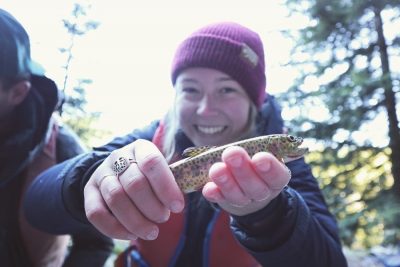 Natalie Benoit is a first-year Master’s student at the Institute for the Oceans and Fisheries (IOF), working with the Hakai Institute‘s Juvenile Salmon Program on Quadra Island. Her field research is based in the Strait of Georgia and Johnstone Strait, where she collects samples of environmental DNA (or eDNA) from Pacific salmon. eDNA is microscopic pieces of genetic material left behind when the fish travel through water. Her work with the Hakai Institute uses laboratory and field experiments to explore whether eDNA could be used to accurately measure the abundance and distribution of juvenile salmon out-migrating into the Pacific Ocean.
Natalie Benoit is a first-year Master’s student at the Institute for the Oceans and Fisheries (IOF), working with the Hakai Institute‘s Juvenile Salmon Program on Quadra Island. Her field research is based in the Strait of Georgia and Johnstone Strait, where she collects samples of environmental DNA (or eDNA) from Pacific salmon. eDNA is microscopic pieces of genetic material left behind when the fish travel through water. Her work with the Hakai Institute uses laboratory and field experiments to explore whether eDNA could be used to accurately measure the abundance and distribution of juvenile salmon out-migrating into the Pacific Ocean.
What sparked your interest in coming to the IOF?
I try to keep in the loop with current research and events in the salmon world and there are so many interesting studies coming out of UBC right now; it’s a great place for cutting-edge research for marine and freshwater species. I’m studying salmon monitoring via eDNA, which is a technique that has gained significantly more attention within recent years. I like the idea of something that’s new and exciting. I was connected to the IOF through a professor in UBC’s Faculty of Forestry. That is where I did my undergraduate degree and began working with salmon, and when I decided I wanted to pursue fisheries research in graduate studies IOF was a good fit.
How has the IOF helped you pursue your research and career goals?
It’s given me a very unique opportunity. My project is with both UBC and the Hakai Institute and the IOF has a strong relationship with Hakai, and with many other groups. I have been able to work with Hakai alongside UBC and learn countless new research techniques. As well, it has allowed me to foster incredible connections to extremely accomplished and inspiring scientists at both UBC and the Hakai Institute. This has truly jumpstarted my scientific career.
Why are you interested in studying salmon?
Pacific salmon are ecologically and physiologically fascinating to me. They are anadromous species, travelling through both fresh and salt water. Some travel over 3,000 kilometres to spawn in their natal rivers. In their travels through the ocean and rivers, they influence the entire ecosystem around them. They do this by impacting the marine and freshwater food web. They also effect the terrestrial landscape by increasing the nutrient composition in riparian zones. Additionally, these keystone species have a lot of history on the B.C. coast. Specifically, they hold incredible importance to the First Nations in the Pacific Northwest.
I think they are the most interesting species due to their ecological, cultural, and economic importance. However, I may be a bit biased.
What’s been the biggest challenge for you since starting the program?
I had much stronger field background than lab background when I started. My lack of lab experience almost deterred me from taking this project on. I had to learn the basics. Due to the pandemic, I had a unique opportunity to get the majority of lab work competed for my thesis. Since beginning in May of 2020 I have spent countless hours in the lab. I started with some basic techniques and now feel very confident in advanced practices.
I’m glad that the lab work didn’t dissuade me. I’ve learned an incredible amount, thanks to my supervisor and the very helpful technicians at the Hakai Institute. I also learned how much I like the lab work!
Related stories:
- Super Salmon Science
- Juvenile Salmon Survival Program gains funding from MITACS and the Tula Foundation
Tags: fieldwork, Hakai Institute, IOF students, Pacific, Pelagic Ecosystems Lab, salmon